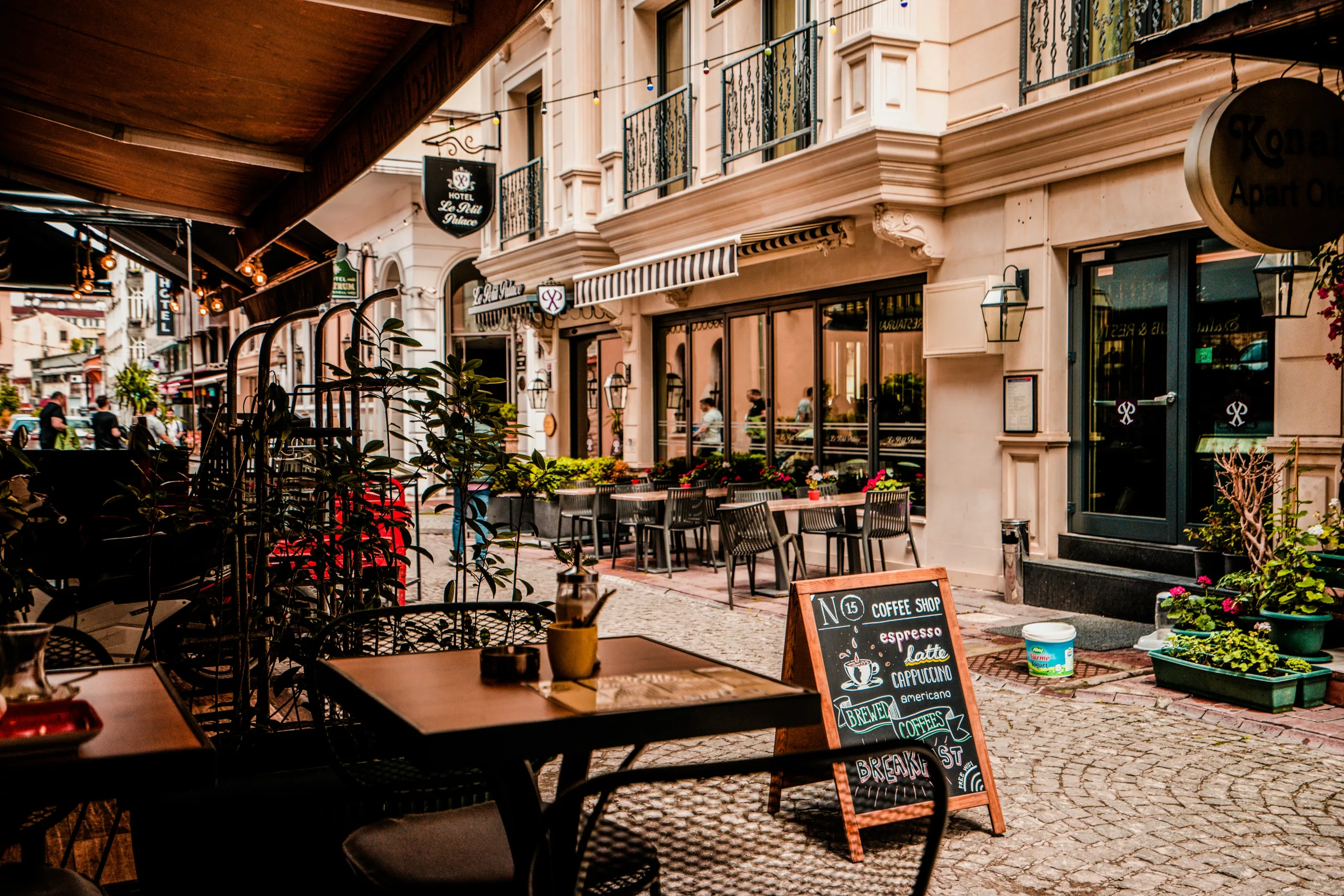Exploring Various Types of Restaurants
Table of Contents
The world of culinary delights is a vast and fascinating landscape of different types of restaurants offering diverse dining experiences to cater to every palate. From charming cafes to luxurious fine dining establishments, the restaurant industry boasts boundless types of restaurants with different flavours, atmospheres, and cuisines that delight and tantalise your taste buds. Whether you’re looking for a cosy spot to enjoy a cup of coffee or a fancy restaurant to celebrate a special occasion, there’s no shortage of options.
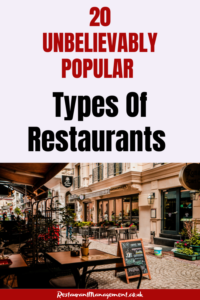
20 Types Of Restaurants:
- Fine Dining Establishments
Fine-dining restaurants epitomise elegance and sophistication, offering exquisite cuisine, impeccable service, and a refined atmosphere. These types of restaurants prioritise culinary excellence and feature gourmet dishes crafted from high-quality ingredients. Patrons can expect meticulous attention to detail in presentation and flavour, making fine-dining restaurants ideal for special occasions or indulgent dining experiences.
Fine Dining Establishments:
- The Fat Duck (Bray)
- The Ritz (London)
- Restaurant Gordon Ramsay (London)
- Le Gavroche (London)
- Sketch (London)
- Casual Dining Restaurants
Casual dining restaurants provide a relaxed ambience and affordable menu options, making them popular for families and individuals seeking a laid-back dining experience. These types of restaurants often feature a diverse menu ranging from comfort foods to international cuisine. Examples include diners, bistros, and casual dining chains.
Casual Dining Restaurants:
- Nando’s
- PizzaExpress
- Wagamama
- Frankie & Benny’s
- TGI Fridays
- Fast Casual
Quick-service restaurants that offer higher-quality ingredients and customisable menu options are known as fast-casual restaurants. These types of restaurants provide a bridge between fast and casual dining, catering to customers who want a quick and convenient dining experience without compromising taste and quality. These establishments prioritise freshness, flavour, and transparency, allowing patrons to build their meals according to their preferences. With their modern decor and streamlined service, fast casual restaurants appeal to health-conscious diners seeking convenient, satisfying dining experiences.
Fast Casual:
- Leon
- Itsu
- Honest Burgers
- Tortilla
- Byron
- Ethnic Restaurants
Ethnic restaurants celebrate the culinary traditions of specific regions or cultures, allowing patrons to explore flavours from around the globe. Whether it’s Italian trattorias, Mexican cantinas, or Japanese sushi bars, ethnic restaurants showcase the diversity of world cuisine and provide diners with authentic flavours and cooking techniques.
Ethnic Restaurants:
- Dishoom (Indian)
- Barrafina (Spanish)
- Yauatcha (Chinese)
- Gauthier Soho (French)
- Rasa (South Indian)
Inside The World Of Quick Bites: Exploring Fast Food Culture
- Fast Food Chains
Fast food chains are synonymous with convenience and efficiency, catering to busy individuals looking for quick and affordable meal options. These establishments specialise in mass-produced food items served rapidly through drive-thru windows or counter service. While often criticised for their reliance on processed ingredients, fast food chains remain popular for their accessibility and consistent menu offerings.
Fast Food Chains:
- McDonald’s
- Burger King
- KFC
- Subway
- Domino’s Pizza
- Coffee Shops
Coffee shops offer a warm and inviting place where customers can enjoy a relaxed cup of coffee, a snack, or a dessert. These establishments foster a laid-back ambience perfect for socialising, reading, or remote work. Cafés offer a comforting respite from the daily grind, placing a premium on freshly brewed coffee and delectable pastries. With an unwavering focus on freshness, customers are guaranteed a delightful experience with every sip and bite. The air is filled with the scent of coffee that has just been brewed, and the irresistible aroma of baked daily pies further enhances the experience of being in a cafe.
Coffee Shops:
- Costa Coffee
- Starbucks
- Pret A Manger
- Caffè Nero
- Tim Hortons
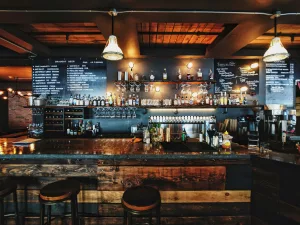
- Cafe
In the bustling streets of the UK, cafes stand as inviting sanctuaries, beckoning weary souls to unwind and rejuvenate. With their charming interiors and welcoming ambience, cafes offer a haven from the urban hustle and bustle. Here, customers can indulge in the simple pleasures of freshly brewed coffee, expertly crafted beverages, and delectable pastries. Whether seeking solace in solitude or engaging in lively conversations with friends, cafes in the UK provide the perfect setting for moments of reflection, creativity, and connection. From quaint corner spots to trendy hangouts, each cafe exudes its unique charm, inviting guests to linger a little longer and savour the essence of British cafe culture.
Cafe:
- The Ivy Café: With several locations across the UK, The Ivy Café offers an elegant yet relaxed dining experience, renowned for its classic British dishes and stylish ambience.
- The Wolseley: Situated in London’s prestigious Mayfair district, The Wolseley is a legendary café known for its grand European-style setting and impeccable service, attracting locals and tourists alike.
- Fernandez & Wells: A beloved café chain in London, Fernandez & Wells is celebrated for its artisanal coffee, freshly baked pastries, and a curated selection of gourmet food items.
- Monmouth Coffee Company: Nestled in London’s Borough Market, Monmouth Coffee Company is revered by coffee enthusiasts for its exceptional single-origin coffees sourced from around the world and its commitment to quality roasting.
- Cafeteria
Cafeterias offer a convenient and efficient dining experience, featuring self-service counters where patrons can select from various pre-prepared dishes. These establishments are commonly found in institutions such as schools, hospitals, and corporate offices, providing quick and affordable meals to large groups of people. Its cafeteria-style layout and diverse menu options cater to various tastes and dietary preferences.
Cafeteria:
- The National Gallery Café (London)
- The Wallace Restaurant (London)
- The V&A Café (London)
- The British Museum Great Court Restaurant (London)
- Tate Modern Café (London)
- Food Trucks and Street Vendors
Food trucks and street vendors bring culinary innovation to the streets, offering gourmet fare in a mobile setting. These establishments often specialise in niche cuisines or creative interpretations of classic dishes, attracting food enthusiasts with their unique flavours and adventurous menus. Food trucks and street vendors add vibrancy to urban landscapes and contribute to the growing popularity of street food culture.
Food Trucks and Street Vendors:
- The Rib Man (London)
- Bleecker Burger (London)
- The Cheese Truck (London)
- The Duck Truck (London)
- The Beefsteaks (London)
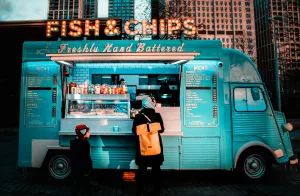
- Buffet Restaurants
Buffet restaurants allow customers to indulge in various dishes for a fixed price, making them popular choices for diners with hearty appetites or diverse tastes. Buffet restaurants are known for their varied food offerings, ranging from classic American dishes to international delicacies. These establishments usually present an extensive selection of dishes for customers. Buffet restaurants appeal to families, large groups, and budget-conscious diners seeking value and variety.
Buffet Restaurants:
- COSMO Authentic World Kitchen (Multiple locations)
- Jimmy’s World Grill & Bar (Multiple locations)
- Red Hot World Buffet (Multiple locations)
- Sakura (Multiple locations)
- Buffet City (London)
- Pop-up Restaurants
Pop-up restaurants are temporary dining experiences that emerge for a limited time in unconventional locations. These ephemeral establishments allow chefs to showcase their culinary creativity and experimental concepts to adventurous diners. Whether hosted in abandoned warehouses, art galleries, or outdoor spaces, pop-up restaurants offer a sense of exclusivity and excitement, attracting food enthusiasts eager to sample innovative cuisine.
Pop-up Restaurants:
- Carousel (London)
- Hawker House (London)
- Street Feast (London)
- Kerb (London)
- Boxpark (Multiple locations)
- Pub
Pubs, or public houses, are beloved establishments known for their cosy atmosphere, hearty fare, and extensive beverage selections. These types of restaurants serve as community hubs where patrons gather to enjoy a pint of beer, savoury pub grub, and lively conversation. With their casual vibe and welcoming environment, pubs offer a quintessential dining experience steeped in tradition and camaraderie.
Pub:
- The Churchill Arms (London)
- The Eagle (London)
- The Dove (London)
- The Mayflower (London)
- The Black Friar (London)
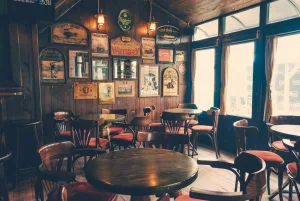
- Ghost Restaurant
Virtual or cloud kitchens, also called ghost restaurants, function exclusively through digital ordering and delivery platforms without any brick-and-mortar location for in-person dining. These establishments focus on efficiently preparing and delivering meals to customers’ doorsteps, often specialising in specific cuisines or menu items. Ghost restaurants capitalise on the growing demand for convenient dining options in the digital age, catering to busy consumers seeking restaurant-quality meals delivered straight to their homes.
Ghost Restaurant:
- Deliveroo Editions (Multiple locations)
- Uber Eats Kitchen (Multiple locations)
- Dark Kitchens (Multiple locations)
14. Bistro
Bistros embody the charm and simplicity of French culinary culture, offering rustic dishes in a casual setting. These intimate eateries specialise in hearty comfort foods and classic bistro fare, such as steak frites, coq au vin, and croque monsieur. With their cosy ambience and unpretentious atmosphere, bistros provide diners with a taste of Parisian gastronomy and conviviality.
Bistro:
- Cafe Boheme (London)
- Petit Bistro (London)
- The French Table (Surbiton)
- L’Absinthe (London)
- The Swan Inn (Surrey)
15. Diner
Diners evoke nostalgia with retro decor, vinyl booths, and classic American comfort foods. These iconic establishments serve hearty breakfasts, diner staples like burgers and milkshakes, and homestyle favourites like meatloaf and mashed potatoes. With their friendly service and timeless appeal, diners offer a taste of Americana and a welcoming dining experience for patrons of all ages.
Dinner:
- The Breakfast Club (Multiple locations)
- Ed’s Easy Diner (Multiple locations)
- The Diner (Multiple locations)
- Polo Bar (London)
- The Diner (Soho)
16. Family Restaurant
Family restaurants cater to diners of all ages, offering a relaxed atmosphere and a menu featuring crowd-pleasing dishes suitable for the whole family. These types of restaurants prioritise affordability, portion sizes, and a welcoming ambience, making them popular for family gatherings and casual dining outings. With their diverse menus and kid-friendly options, family restaurants provide a comfortable and inclusive dining experience for patrons of all generations.
Family Restaurant:
- Harvester (Multiple locations)
- Brewers Fayre (Multiple locations)
- Beefeater (Multiple locations)
- Toby Carvery (Multiple locations)
- Pizza Hut (Multiple locations)
17. Pizzeria
Pizzerias specialise in crafting delicious pizzas topped with various fresh ingredients, baked to perfection in wood-fired or deck ovens. These establishments range from casual takeout joints to upscale pizzerias offering gourmet pies with artisanal toppings. With their aromatic crusts, bubbling cheese, and endless topping combinations, pizzerias satisfy cravings for this beloved Italian dish and provide a communal dining experience for pizza lovers everywhere.
Pizzeria:
- Franco Manca (Multiple locations)
- Pizza Pilgrims (Multiple locations)
- Pizza Hut (Multiple locations)
- Pizza Express (Multiple locations)
- Dominoes Pizza (Multiple locations)
- Yard Sale Pizza (Multiple locations)
18. Bakery
Bakeries are havens for pastry enthusiasts, offering freshly baked goods, sweet treats, and artisanal bread. These establishments delight the senses with the aroma of freshly baked bread, the sight of elaborately decorated cakes, and the taste of flaky croissants and buttery pastries. With their dedication to quality ingredients and time-honoured baking techniques, bakeries provide a taste of indulgence and craftsmanship to patrons seeking a sweet escape.
Bakery:
- Gail’s Bakery (Multiple locations)
- Paul (Multiple locations)
- Patisserie Valerie (Multiple locations)
- E5 Bakehouse (London)
- Bread Ahead (Multiple locations)
19. Pop-up Restaurant
Pop-up restaurants are temporary dining experiences that emerge for a limited time in unconventional locations, offering diners the opportunity to sample unique culinary creations and experimental concepts. These ephemeral establishments showcase the creativity and innovation of chefs, who use pop-up restaurants as platforms to test new ideas, collaborate with fellow culinary professionals, and engage with diners in intimate settings. With their sense of spontaneity and exclusivity, pop-up restaurants add excitement and intrigue to the dining scene, enticing adventurous food enthusiasts eager to discover the next culinary sensation.
Pop-up Restaurant:
- Dinerama (London)
- The Last Days of Shoreditch (London)
- The Magic Roundabout (London)
- Pop Brixton (London)
- Pop Fields (London)
20. Buffet Style Kitchen
Buffet-style kitchens allow customers to customise their dining experience by selecting from various dishes displayed on self-service counters. Buffets at these establishments are extensive and offer multiple cuisines, including traditional comfort foods and international specialities. With their all-you-can-eat offerings and diverse menu options, buffet-style kitchens appeal to diners seeking value, variety, and the flexibility to sample a little bit of everything.
Buffet Style Kitchen:
- SushiSamba (London)
- The Restaurant at Sanderson (London)
- Inamo (London)
- Grand Royal Buffet (London)
- Mr. Bao (London)
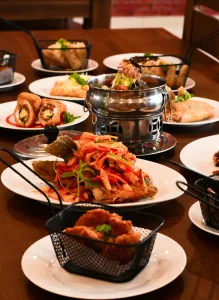
Pricing
Pricing in restaurants varies depending on factors such as location, cuisine, ambience, and service quality. Fine dining establishments typically command higher prices because they emphasise premium ingredients, exquisite presentation, and attentive service. Casual dining restaurants offer more affordable options without sacrificing flavour or quality, making them accessible to a broader range of diners. Fast food chains focus on affordability and convenience, with value menus and combo deals catering to budget-conscious consumers. Ultimately, restaurant pricing balances cost, value, and dining experience.
Related articles:
Most Profitable Restaurant Types
How To Improve Restaurant Profits
Restaurant Inventory Management System
Conclusion: Types of Restaurants
The culinary industry of restaurants is extensive and constantly evolving, providing various dining experiences to suit different tastes and occasions. Each type of restaurant offers its unique service, atmosphere, and flavours, contributing to the diverse tapestry of gastronomic culture that diners worldwide enjoy. Whether it’s cosy bars, busy coffee shops, or creative pop-up restaurants, there’s something for everyone’s preference and palate in the rich fabric of restaurant culture.
Frequently Asked Questions And Answers
What is the most popular types of restaurants?
The most popular type of restaurant can vary depending on location, culture, and current culinary trends. However, casual dining restaurants are among the most popular globally due to their relaxed atmosphere, affordable menu options, and broad appeal to diverse demographics. Casual dining establishments offer a balance of comfort, quality, and value, making them popular for families, friends, and individuals seeking a casual dining experience without sacrificing flavour or ambience.
What are the two main categories of restaurants?
Restaurants are generally divided into two main categories: full-service and limited-service:
- Full-Service Restaurants: Full-service restaurants often feature diverse menus, alcoholic beverage options, and amenities like reservations, ambience, and attentive service.
- Table service is provided by these establishments, where a host or hostess will seat customers and waitstaff will serve them. Examples include fine-dining restaurants, casual dining chains, and upscale bistros.
Limited-Service Restaurants: Limited-service restaurants, also known as quick-service or fast-food restaurants, provide counter service or self-service options, where patrons place their orders at a counter and retrieve their food to-go or at designated seating areas. Limited-service restaurants prioritise speed, convenience, and affordability, often featuring standardised menu items, efficient service models, and drive-thru or delivery options. Examples include fast-food chains, cafes, and food trucks.
What are the five types of food menus?
The five types of food menus commonly found in restaurants are:
- A la carte menu: Offers individual dishes priced separately, allowing patrons to create customised meals by selecting items from various categories such as appetisers, entrees, and desserts.
- Table d’hôte menu (Table of the Host): Features a fixed-price meal with a set number of courses, often offering multiple options for each course to accommodate different preferences.
- Du jour menu (Menu of the Day): This refers to the practice of prominently featuring the daily specials or seasonal dishes so that customers are aware of the fresh ingredients or the chef’s recommendations.
- Cycle menu: Rotates through a predetermined sequence of menus over a specific period, such as weekly or monthly, offering variety while maintaining consistency and efficiency in meal preparation.
- Static menu: Maintains a consistent selection of dishes over time, with occasional updates or additions to reflect seasonal changes or culinary trends.
What are the three areas of the restaurant?
The three main areas of a restaurant typically include:
- Front of House: Also known as the dining area, the front of the house encompasses the spaces where patrons dine and interact with restaurant staff. This area includes the entrance, host/hostess station, dining tables, bar counter (if applicable), and other amenities or decor designed to enhance the dining experience.
- Back of House: The back of house refers to the kitchen and food preparation areas where chefs, cooks, and kitchen staff work to prepare and plate dishes for service. This area includes the kitchen, food storage areas, dishwashing station, and other facilities or equipment necessary for food production and sanitation.
- Service Areas: Service areas facilitate the flow of food and beverages from the kitchen to the dining area, ensuring efficient service and smooth operations. Service areas include server stations, beverage stations, expediting areas, and other spaces dedicated to promptly coordinating and delivering orders to patrons.
The smooth functioning of a restaurant’s front-of-house, back-of-house, and service areas is crucial in providing a seamless dining experience to customers. Each area is vital to the restaurant’s overall operation and success. The coordination and cooperation among these areas are essential for ensuring the satisfaction of patrons.

